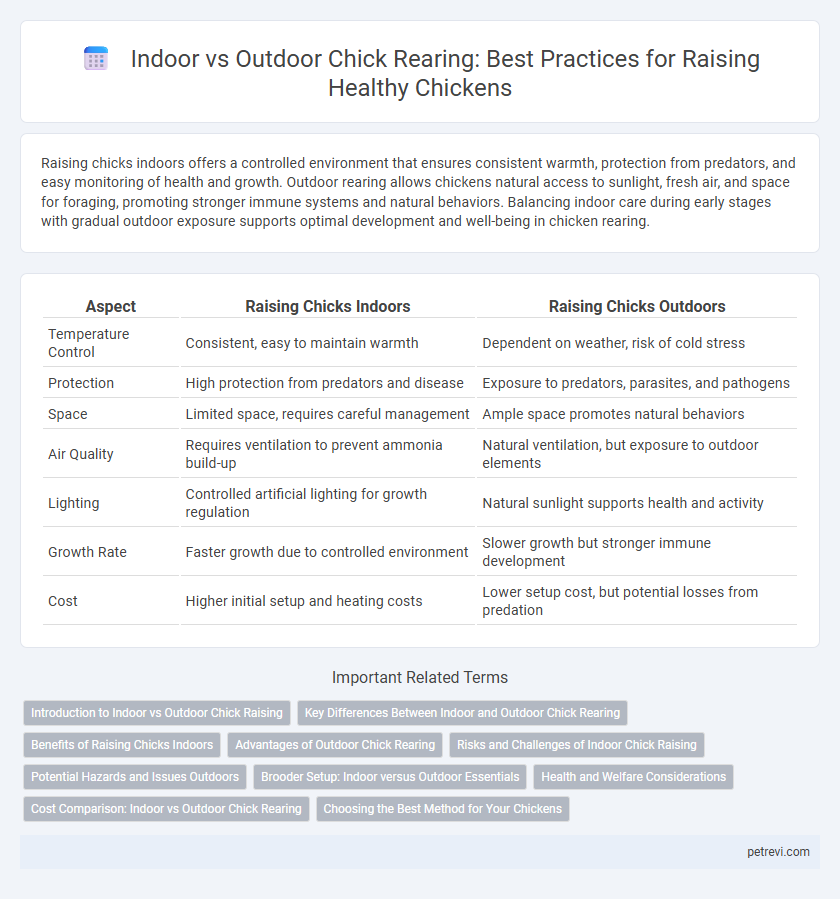Raising chicks indoors offers a controlled environment that ensures consistent warmth, protection from predators, and easy monitoring of health and growth. Outdoor rearing allows chickens natural access to sunlight, fresh air, and space for foraging, promoting stronger immune systems and natural behaviors. Balancing indoor care during early stages with gradual outdoor exposure supports optimal development and well-being in chicken rearing.
Table of Comparison
| Aspect | Raising Chicks Indoors | Raising Chicks Outdoors |
|---|---|---|
| Temperature Control | Consistent, easy to maintain warmth | Dependent on weather, risk of cold stress |
| Protection | High protection from predators and disease | Exposure to predators, parasites, and pathogens |
| Space | Limited space, requires careful management | Ample space promotes natural behaviors |
| Air Quality | Requires ventilation to prevent ammonia build-up | Natural ventilation, but exposure to outdoor elements |
| Lighting | Controlled artificial lighting for growth regulation | Natural sunlight supports health and activity |
| Growth Rate | Faster growth due to controlled environment | Slower growth but stronger immune development |
| Cost | Higher initial setup and heating costs | Lower setup cost, but potential losses from predation |
Introduction to Indoor vs Outdoor Chick Raising
Raising chicks indoors offers controlled temperature, protection from predators, and easier monitoring of health and growth, making it ideal for early development stages. Outdoor chick raising provides natural sunlight, fresh air, and opportunities for exercise, promoting stronger immune systems and natural behaviors. Balancing indoor brooding with gradual outdoor exposure optimizes chick survival and long-term vitality in poultry farming.
Key Differences Between Indoor and Outdoor Chick Rearing
Raising chicks indoors provides a controlled environment with consistent temperature, protection from predators, and easier monitoring of health and growth, which is crucial during the first few weeks of life. Outdoor chick rearing promotes natural behaviors, improved air quality, and access to sunlight for vitamin D synthesis but exposes chicks to variable weather conditions and higher risks from predators. Key differences include the level of environmental control, risk exposure, and behavioral development opportunities, impacting overall chick survival and welfare.
Benefits of Raising Chicks Indoors
Raising chicks indoors provides a controlled environment that enhances temperature regulation, reducing exposure to harsh weather and predators, which significantly improves survival rates. Indoor rearing facilitates close monitoring of chick health and diet, allowing for timely interventions and optimal nutrition to promote faster growth. This method also minimizes the risk of diseases and parasites common in outdoor settings, ensuring stronger, healthier chickens for future productivity.
Advantages of Outdoor Chick Rearing
Outdoor chick rearing promotes natural behaviors such as foraging, exercise, and social interaction, leading to healthier and more robust chickens. Exposure to sunlight enhances vitamin D synthesis, improving bone development and immune function. Furthermore, outdoor environments reduce the risk of respiratory diseases often caused by poor indoor air quality.
Risks and Challenges of Indoor Chick Raising
Raising chicks indoors poses risks such as poor ventilation leading to respiratory issues and increased susceptibility to disease due to confined spaces. Indoor environments require strict management of temperature, humidity, and cleanliness to prevent stress and growth delays in chicks. Challenges also include limited space for natural behaviors, which can result in behavioral problems and weakened immune systems.
Potential Hazards and Issues Outdoors
Raising chicks outdoors exposes them to predators such as foxes, hawks, and raccoons, significantly increasing mortality risks. Outdoor environments also present challenges like unpredictable weather, parasites like mites and lice, and exposure to diseases from wild birds. Proper shelter and vigilant monitoring are essential to mitigate these hazards and ensure chick survival and health.
Brooder Setup: Indoor versus Outdoor Essentials
A proper brooder setup for chicks requires controlled temperature, adequate ventilation, and predator protection, which are more easily managed indoors with heat lamps and insulated enclosures. Outdoor brooders need secure fencing, weather-resistant materials, and natural light exposure while ensuring warmth through portable heaters or insulated pads. Both setups demand clean bedding and easy access to food and water to promote healthy chick development.
Health and Welfare Considerations
Raising chicks indoors offers a controlled environment that reduces exposure to predators, parasites, and extreme weather, promoting early-stage health and steady growth. Outdoor rearing enhances natural behaviors such as foraging and exercise, which support mental well-being and stronger immune systems but requires vigilant management of biosecurity risks like avian diseases. Balancing indoor brooders with secure outdoor access can optimize health outcomes by combining protection with natural enrichment for chick welfare.
Cost Comparison: Indoor vs Outdoor Chick Rearing
Raising chicks indoors typically incurs higher costs due to the need for heating, specialized lighting, and controlled ventilation systems to maintain optimal growth conditions. Outdoor chick rearing reduces expenses by utilizing natural sunlight and ambient temperatures, but may require investments in predator-proofing and weather protection to ensure chick safety. Overall, indoor rearing demands increased energy and equipment expenditures, while outdoor methods benefit from lower utility costs but potentially higher maintenance for environmental safeguards.
Choosing the Best Method for Your Chickens
Raising chicks indoors offers controlled temperature, protection from predators, and easier monitoring of health, making it ideal during their vulnerable early weeks. Outdoor rearing promotes natural behaviors, improved muscle development, and access to sunlight, enhancing overall well-being and egg quality. Evaluating your local climate, available space, and biosecurity needs will help determine the best environment for optimal chicken growth and productivity.
Raising Chicks Indoors vs Outdoors for Chicken Rearing Infographic

 petrevi.com
petrevi.com